Rachel Neumeier's Blog, page 316
January 7, 2016
It’s like personalized medicine, only useful for absolutely everybody all the time
Interesting article about a newly developed algorithm that personalizes your diet based on your specific blood sugar reactions to specific foods.
By comprehensively monitoring the blood sugar, diets, and other traits of 800 people, [Eran Elinav and Eran Segal from the Weizmann Institute of Science] built an algorithm that can accurately predict how a person’s blood-sugar levels will spike after eating any given meal.
They also used these personalized predictions to develop tailored dietary plans for keeping blood sugar in check. These plans sometimes included unconventional items like chocolate and ice-cream, and were so counter-intuitive that they baffled both the participants and dieticians involved in the study. But they seemed to work when assessed in a clinical trial, and they hint at a future when individuals will get personalized dietary recommendations, rather than hewing to universal guidelines. . . .
The team found a huge amount of variation between the volunteers. The same food would cause huge sugar spikes in some people but tiny blips in others. The volunteers also differed substantially in the foods that triggered the sharpest spikes: Participant 445, for example, reacted strongly to bananas, while participant 644 spiked heavily post-cookies. . . . Zeevi and Korem showed that these personal differences were influenced by familiar factors like age and body mass index, and also less familiar ones like gut microbes.
Eight months or so of fairly casual experimentation with my own diet suggests to me that:
a) Low-carb is definitely the way to go if I want to keep my weight in an acceptable range,
b) It takes me very little time to get very, very tired of a zero-carb diet,
c) Oatmeal and legumes are more acceptable carbs for me than wheat, at least wheat flour (I’m cooking wheat berries right now and we’ll see what happens),
d) The jury is still out on rice and rice products,
e) A little sugar seems to be less awful for me than a little wheat,
f) Apples are fine, and
g) Nothing on Earth will make me quit eating dark chocolate, but luckily that seems to be okay, even in surprisingly generous amounts.
Deliberate, rigorous experimentation is a pain in the neck, though. I would welcome a chance to participate in a study of this kind, but apparently they have no trouble at all filling out their roster of volunteers with friends and relatives of earlier participants.
The connection with gut microbes strikes me as particularly interesting, given fairly strong indications that use of antibiotics can permanently alter gut bacterial communities and lead to weight gain; see for example this and this. That suggests a two-pronged (at least) approach to controlling weight gain, of course — it might well pay off to figure out ways to rebalance gut fauna after antibiotic use, as well as make this personal algorithm more broadly available.
Good to have a couple promising pathways to pursue when it comes to weight-gain issues. Faster, please.

January 6, 2016
Books that are heading for the big screen
Apparently there are a whole lot of books that are going to come out as movies in 2016. I mean, nineteen? Are there always that many book-based movies that come out in a given year? I am the last person to ask about movie trends, but that seems like a ton to me.
Pride and Prejudice and Zombies? Huh. I glanced at that when it came out, but honestly, I didn’t really think the conceit could carry a whole book. I read about a chapter. It might make a fun movie, though.
Another Tarzan remake. Well, whatever.
Ms Peregrine’s Home for Peculiar Children was a pretty good book — I liked it better before we started to find out The Truth. Some stories are like that; you like wondering what the heck is going on better than finding out. I bet it makes a good movie, though.
I’ve never read The 5th Wave, but I have to say, the movie sound like just my kind of thing.
Look at this cast for this live action/CGI adaptation of The Jungle Book: Lupita Nyong’o, Scarlett Johansson, Idris Elba, Bill Murray, Neel Sethi. Frankly, this is the one that sounds like a must-see to me! I loved The Jungle Books as a kid and read them over and over.
To my mind, though, none of this is as exciting as the BBC adaptation of China Mieville’s The City and the City.

January 4, 2016
Advice from Robert Jackson Bennett
Oh by the way, yet another book to keep an eye out for in 2016: CITY OF BLADES by Robert Jackson Bennett. It’s the sequel to CITY OF STAIRS, which you may recall got a fair bit of buzz last year. I liked CITY OF STAIRS quite a bit, though not as much as some people did. I do want to pick up this sequel, I’m definitely curious enough about where Bennett’s taking the trilogy for that.
But that’s not the point of this post. Via Twitter, I happened across this post by Bennett: Some advice to aspiring writers who wish to make a living off of writing. And in fact it struck me as Really Good Advice.
A lot of posts with that kind of title would be all about how to monetize all kinds of writing and pick up freelance work on the side and all like that, the kind of advice which always strikes me, frankly, as too much trouble if what you actually want to do is write novels. But that is not what this post is about. Instead, here is what Bennett advises:
As I get older – and I know I’m not old, but I am approaching middle age – I’m growing increasingly aware that so much of your future career rests upon the decisions you make in your twenties, when you are likely at your stupidest and horniest. When I was in my twenties, I thought I would just work crappy jobs and keep writing until I was successful.
I made that decision a decade ago. I moved from job to job based on whether or not it paid a dollar an hour more. There were a lot of call centers. I wasn’t on the fast track to big career success by a long shot.
Then I got lucky. I met the right person, who helped me get a decent job that made me actually think and work. If I had not known that person, I would not have gotten that job.
To my surprise, I found it stimulating. I found it meaningful. And I did well at it. A good job, I found, made me feel better and write better.
Bennett’s point is that planning to be The Starving Writer in a Garret is not the world’s greatest plan, that having a real life outside of writing can lend energy to your writing rather than suck it away, and that making sure you have marketable skills is probably a pretty good idea.
There is a vast preponderance of art and literature and pop culture that casts the twenty-something wandering artist as a figure to aspire to, perhaps not so much a career as a lifestyle choice.
I think this is true. And I completely agree with Bennett that this is potentially a very destructive image for a young would-be writer to have in his or her head.
Speaking as someone who has a day job, and is glad of it and has no wish to give it up any time in the near future — yes. What he said.
Mind you, what I have is a part-time low-stress day job, so I really have the best of both worlds. Nevertheless, I would definitely encourage any twenty-something writers to take a good look at Bennett’s post and think hard about how they might ideally arrange their lives, given the idea that a real job and a real life are probably going to be necessary, but may well also enhance, their enthusiasm for writing.

Recent Reading: POWERS by James A Burton
First, let me mention that it turns out that James A Burton is really James A Hetley, with another half dozen or so books to his credit. THE SUMMER COUNTRY is on sale now and on the strength of POWERS, I picked it and its sequel up without even bothering to read the descriptions. Also another story called GHOST POINT, because I did read the description of that one and it sounded promising. There are others, too, so we’ll see after I have a chance to try these.
Also, I also see that a sequel to POWERS, DOMINIONS, came out last year, so I picked that up as well, of course, and I’m definitely looking forward to reading it.
Anyway, POWERS:

The air hummed, oily golden liquid condensed out of sparkling haze, and a demon took human shape across the table from Albert Johannson. The thing stood at an angle to the world until it put one glowing hand on the scarred Formica tabletop and twisted to vertical without apparent movement, as if concepts of up and down were optional and it had to locate itself in space.
I had collected a reasonable number of samples over the past year, and yesterday was my day to read through a bunch of them, deleting as I went, until I reached one I couldn’t put down. POWERS was that one. Initially, it was the writing that grabbed me. I love the passage above. Description, it turns out, is a major strength for Burton. Not the only strength. Characterization and pov were handled in an unusual manner in this story, which was told almost as a stream of consciousness from Albert’s viewpoint, even though the story is told in third-person:
Feel the iron, smell the iron, hot in the coals. Read the temperature by eye. No welding here, no blazing white sparks flying from each strike of hammer on hot metal. Uniform red heat, a human would just see it as a glow, he saw something more – he saw iron willing to change in certain ways. Tongs came to his hand as if he’d called them, gripping, setting the glowing cane shaft between the jaws of the swage, tapping rather than pounding, matching rounded grooves along both sides of the shaft, up the length and then down again, to taper out a couple of inches from each end, up and back, widening, deepening, then back into the fire, judge the glow, up and down the shaft again, smoothing, fire again, swage again. Turn a quarter in his tongs, a second set of grooves, four total as he saw the finished work in his head.
Albert is plainly a smith, and not any ordinary smith, either. He is not exactly human. Who and what he is, is a mystery, especially to himself. His memories go back a long, long way, but they are as filled with holes as lacework. We find out why that is as the story goes on.
At first this novel looks like it might be an Urban Fantasy. It’s set in a gritty modern city and the important secondary character is a cop. Well, among other things, she is a cop. But actually this is not UF. It belongs, more or less, to the sub-sub-genre of mythological fantasy. I don’t like gods, Albert thinks on more than one occasion, but as he discovers, he is a god himself. If I tell you that he’s lame and a superlative smith, I bet you can figure out which god he is – which is more than he can; he never does recover much of his memory, not during the course of this book.
But this is not a story that restricts itself to one pantheon. The important secondary character is Mel el-Hajj, who is also a goddess, and knows it, though she, too, has dwindled over the centuries. She’s a Middle Eastern goddess of the winds, also associated somehow with Kali. There are strong implications that gods in this world might not confine themselves to neat categories and that very different myths might have grown up around various gods.
Anyway, whoever she exactly is or used to be, Mel is definitely prickly and dangerous. The first words she speaks to Albert are: Now what in the name of Allah’s eight million afreets are you? And then a moment later, If Allah so wills, I’ll drink your blood. … I don’t need some soft-hearted law of the infidel dogs for vengeance.
So, the writing is excellent, if in an unusual style; and the characterization is also unusual and very good. There are essentially only two characters – other secondary characters are much less important, although of course they can be important for driving the plot, and they are drawn effectively in their few lines. I loved the tight focus on just a couple important characters. That intimate focus normally works better for me than a huge cast. I mean, I like epic fantasy, but the stories I actually fall in love with are generally smaller scale, like this one.
Also, you know how from time to time one sees comments about loving unlikeable female characters – well, if that’s you, here you go. Mel is probably my favorite “unlikeable” female character since Tremaine in Martha Wells’ Ile-Rien trilogy. Though the stories are very different, Mel’s got the ruthless competence in spades, plus the loyalty to her own people. We do have a romance here, but it is very (very) slow to develop and I found the progression of the relationship believable.
The pacing of this story could seem slow, I guess, as Burton paints the world(s) for the reader. In fact, checking out the reviews on Goodreads, I see various readers have found it slow. I enjoyed the pace, leisurely as it was at times, because I enjoyed the characters and the setting and the description. Given all that, I don’t mind a bit if the pacing is slow.
Thankfully, the setting is not all gritty and poor, because with an unpleasant setting, description is a two-edged sword. But in addition to the urban slums where the story begins, we also get another world, almost all wilderness, and also the peculiar place between the worlds. The description throughout is dreamlike, or occasionally nightmarish. The most beautiful description is probably of the smithing, or maybe of the immense subtly landscaped territory in the other world.
The plotting is intelligent, even elegant, in how it arises directly out of the characters’ backgrounds and motivations. We don’t understand everything at the end, because this is such a close third-person narrative and Albert doesn’t understand everything. But we understand the essentials, including why the protagonists chose to go on with their quest even after they understood that success as well as failure is going to carry substantial costs. The ending is satisfying and this book stands quite well on its own, even though a sequel is due out shortly.
Overall rating: Oh, no question, for me this is a five out of five. Maybe nine out of ten. This was a really promising book and a great new-to-me author to stumble across so early in the year; may POWERS be an omen for the rest of 2016!

Happy birthday to JRR Tolkien
Via tor.com, Emily Asher-Perrin writes: J. R. R. Tolkien Went into the West, but Gave Us Middle-earth
It’s January 3, which means that on this day, in 1892, John Ronald Reuel Tolkien was born…. It denotes a particular status as a writer to have your name instantly associated with an entire genre, and indeed, it is impossible to call up the names of science fiction and fantasy authors and not include Tolkien. He intended with his works to create stories that entered our mythic consciousness, a feat that he accomplished in every sense.
I do think it’s odd to consider how many people probably think of the movies before the books. Still, whether you came to Tolkien via one or the other, you could do worse than check out Shippey’s book:
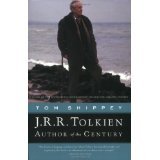
Because in reading this, you will certainly find *even more* to admire about Tolkien and The Lord of the Rings.

Clear proof that Monet met The Doctor
Via File 770, this fantastic painting:
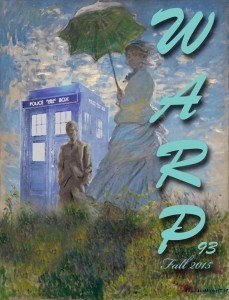
Little is known of the subjects depicted as the artist left no notes as to their identity or relationship to him. No particulars on the gentleman or lady are to be found, either, in the local historical records of the time and the odd structure beside which the gentleman is standing remains a puzzle.
Click through to read the whole thing.

January 3, 2016
Errors of beginning writers
Sherwood Smith has an interesting post up at Book View Café, which is not exactly about the mistakes made by beginning writers. It is about the response to this topic at a LosCon panel twenty or so years ago.
Sherwood says: “I think these lists interesting mostly because they reveal writerly process at least as much as they do beginner errors. Some of the best discussion arose out of what some considered no error at all, and others considered advice for revision, not for first draft errors, and what the difference was.”
Yes, that’s going to happen when you get a bunch of writers together and start talking about common mistakes. The process of writing is going to get conflated with the outcomes of writing.
Panelist’s Three’s list suggests to me that that writer works by a completely different process:
1.Ending every chapter on a transition.
2.Letting the narrative voice tell readers what to think.
3.Long, clumsy sentences.
To number one, half the panelists disagreed. Note: “transitions are natural chapter breaks.” The writer defended it: “this pattern reads artificial.”
Interesting argument! It depends on how you define “transition” and how you handle transitions, I suppose. I end chapters where feel they could reasonably end, but you always definitely have a choice of ending points. When my editor sent me her initial comments on KEEPER OF THE MIST, she suggested keeping chapter lengths to around 10 pages when my natural tendency was toward 20 or more pages per chapter. She said a book would feel faster-paced with shorter chapters. The point is, I went through and broke every chapter more or less in half and really, this was not difficult. So obviously you can choose different spots at which to end a chapter and they can work perfectly well.
I’ve seen some authors who end every chapter on a cliffhanger. That can sure get readers to turn the page and start the next chapter. It might annoy a reader who feels that this “reads artificial,” though.
Does anybody remember DOORWAYS IN THE SAND by Roger Zelazny? He starts every chapter with the protagonist in a cliffhanger of a situation, then he goes back to show how he got into that situation, then he gets him out of it. Then he starts the next chapter with a new, unrelated cliffhanger. Artificial? Sure, and it’s not like the reader isn’t going to notice the pattern. But this is also fascinating and compelling. Of course a less skilled writer probably could not pull that off.
Anyway, the comments to Sherwood’s post are also interesting, especially this one by Judith Tarr:
One thing I’m seeing in literally every not-ready-for-prime-time ms. is what I call “offstaging.” Or writing in negative space. Writing all around the real action. Characters talk about what happened, what is happening now, or what is going to happen. While it all happens elsewhere. Revision is as simple (if never easy) as getting rid of what’s there and writing what’s not there.
Every now and then you see that in a published book, but I didn’t realize it was such a typical issue.

Yet more exciting titles due out this year
The problem with “books I’m anticipating with glee” types of posts is that you always forget a couple that are really at the top of your list. I’m sure that’s not just me. So let me add to the earlier post a handful of titles I’ve been reminded of by other peoples’ most-anticipated lists.
The Edge of Worlds by Martha Wells
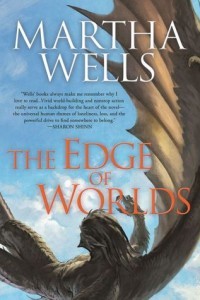
I mean, another Raksura book? I am THERE.
[T]he Indigo Cloud court had been plagued by visions of a disaster that could destroy all the courts in the Reaches. Now, the court’s mentors believe [a newly discovered] ancient city is connected to the foretold danger. A small group of warriors, including consort Moon, an orphan new to the colony and the Raksura’s idea of family, and sister queen Jade, agree to … investigate. But the predatory Fell have found the city too, and in the race to keep the danger contained, the Raksura may be the ones who inadvertently release it.
Sign me up. Then we also have:
Children of Earth and Sky by Guy Gavriel Kay
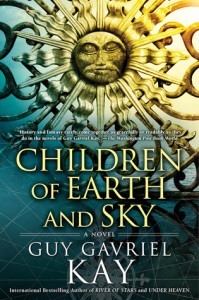
Although after River of Stars, I may want to check and make sure this one is not a grand, sweeping tragedy. Set in a world inspired by the conflicts and dramas of Renaissance Europe, says Goodreads. Big cast, lots going on, or so the description indicates. Well, I’m sure it’ll be beautiful. GGK is such a poet of a writer.
And besides that, we have The Obelisk Gate by NK Jemisin.
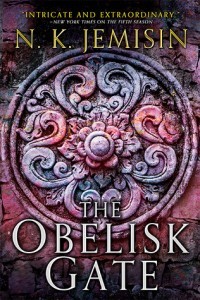
Which is the sequel to The Fifth Season, which I was (and still am) wary of because the description sounds so grim. Well, this is a trilogy, I believe, so I think I will probably not rush into the series. Plenty of time to see how readers I follow respond to the trilogy as a whole.
Meanwhile, from By Singing Light, I am reminded of:
Icon, the sequel to Persona by Genevieve Valentine, a book I haven’t read yet, but one that’s on my TBR shelves because I’ve heard good things about it.
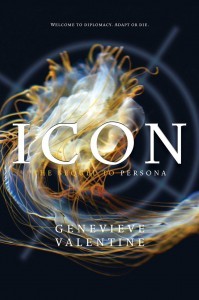
Then Geekritique has reminded me about:
The Raven King by Maggie Stiefvater.
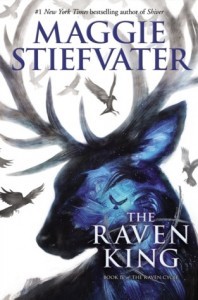
The Raven King! How could I forget? I have been waiting and waiting for this quadrilogy to be finished. As soon as this one is released, I’m free to read the whole series from the top, starting with a re-read of The Raven Boys. Until I get around to that, I won’t be reading any reviews of this one — not even the back cover copy. I look forward to reading straight through with no spoilers.
Also coming out this year, The Thorns of Emberlain by Scott Lynch.
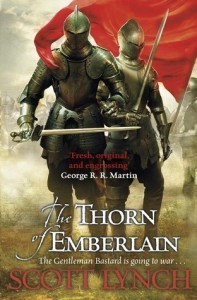
I think there is one more book in this series, but I have been reading them as they come out and I expect I will do the same with this one rather than waiting. Lynch is doing a good job of catching the reader up with each book, and I found the last one worked well without re-reading from the start of the series.
Unlike Lynch’s series, though, I will definitely be waiting for Django Wexler to finish up his series before I go back and re-read the first couple and then go on with it. But in the meantime, I will admire this one on my shelves:
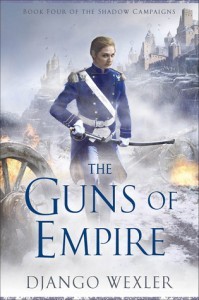
Guns of Empire by Django Wexler.
I loved the first book, . I definitely look forward to re-reading it. And I also liked the second book very much, and I’ve heard good things about the third. The completion of this series, I presume in 2017, definitely counts as Most Anticipated Series Ending, even this far in advance.
So, yes, lots to anticipate in 2016 so far, and I’m sure we’ll all be excited about the second half of the year when we get there.
Let me just add that I’m so pleased and flattered to see The Keeper of the Mist popping up here and there on most-anticipated lists, too. Thank you all.

January 1, 2016
Recent Reading: Masks and Shadows by Stephanie Burgis
You all know, I expect, that Stephanie Burgis is the author of the Kat, Incorrigible middle-grade series. Though I read a little MG, as a general rule I am much more into YA and adult, so I have been really pleased to see some of the MG authors I know and admire move into YA and adult – Sarah Prineas with ASH AND BRAMBLE, which is on my TBR pile, and now Stephanie Burgess with MASKS AND SHADOWS, which is officially out this coming April.
Okay, so, MASKS AND SHADOWS.
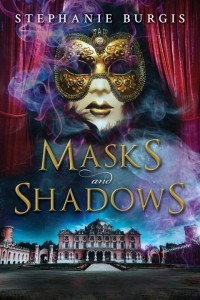
This is a beautiful cover, evocative although not specifically representative of the story, which is set in the late 1700s, in the Habsburg Empire – not a setting I’m particularly familiar with. The only historical character whom I recognized was Joseph Haydn and I can’t claim to know much about him, either. I see via Wikipedia that he really was employed by the Esterházy family for a good part of his career. I expect plenty of historically aware readers would probably know a good deal more than I do about many of the other secondary characters, like the Emperor and Empress of the Habsburg Empire.
The story itself, it turns out, is not just about opera, it actually is an opera. It is filled with passion and drama, evil plots and heroic rescues, spurned wives and pouting mistresses, demon-summoning alchemists, ambitious noblemen, and the most famous castrato singer in Europe. Point-of-view characters are abundant, scenes are short, and the whole story weaves together just like a fast-paced stage production. You can practically hear the operatic score as each character steps onstage and each scene progresses.
This took me a bit by surprise, because an opera is not really the same thing as a novel.
In MASKS AND SHADOWS, we have quite a large cast, including Charlotte von Steinbeck, recently widowed and now visiting her sister in Eszterháza; and Carlo Morelli, the castrato singer; and a good many others.
My favorite pov character was Anna, who starts out as Charlotte’s maid and is unexpectedly recruited as a soprano, though she doesn’t know anything about opera or acting, can’t read music, and doesn’t even speak Italian. What a situation! Innocent, even sheltered, but brave, Anna drives the plot at least as much as any character mentioned in the back cover copy. I would have liked a novel at least twice as long as this one, mainly focused on her.
My favorite secondary character was Princess Esterházy, set aside by her husband in favor of a pretty, shallow, selfish twit of a girl. The Princess, with her clever, clear-sighted bitterness and her startling companions, would also have made a great main character in her own novel.
Given the actual structure of the story, however, there wasn’t much room to develop Anna, or the Princess, or anyone else. Some room, yes, and a couple of the pov characters take unexpected roles as the crisis unfolds, but this was really not that kind of novel. If you’re into opera, though, chances are good you’d enjoy this one, especially if you’re familiar with the historical period.
The only other novel I can think of that is really an operetta is the brilliant HOW MUCH FOR JUST THE PLANET by John Ford – and that’s a Gilbert & Sullivan comedy disguised as a Star Trek novel. Can anybody else suggest a novel that strikes the reader as “really” something other than a novel?

December 31, 2015
Looking forward to 2016
There were certainly times when 2015 seemed to drag on a bit, and yet the end of the year seems to have rushed up while I wasn’t paying attention.
My TBR pile grew in 2015, and there are sure a lot of books that came out in 2015 that I urgently want to read, but of course now there also are a good handful of titles coming out in 2016 that will just have to take priority.
For example, we have new titles coming out by Lois McMaster Bujold, CJ Cherryh, Patricia McKillip, and Patricia Briggs.
GENTLEMAN JOLE AND THE RED QUEEN is kind of a cumbersome title, but whatever. Obviously I will be happy to grab it off the shelves no matter what its title is.
Cherryh’s new one is VISITOR, obviously the next in the Foreigner universe. I can’t wait. No cover available yet, but I’m sure we can all have a good picture of Bren and Jago and everyone in our heads by this point.
Briggs is coming out with another Mercy Thompson novel, FIRE TOUCHED. The summary says: “Tensions between the fae and humans are coming to a head. And when coyote shapeshifter Mercy and her Alpha werewolf mate, Adam, are called upon to stop a rampaging troll, they find themselves with something that could be used to make the fae back down and forestall out-and-out war: a human child stolen long ago by the fae.” That thing with the fae has got to take center stage eventually, so apparently now is the time.
And then, of course, there’s McKillip’s KINGFISHER. I don’t need to know anything about that one to know I’m right there for it.
All of those are autobuy authors for me, all of them greatly anticipated. If I had them all on a stack in front of me right now, I hardly know which one I would reach for first. It’ such a pleasure to step back into a familiar world like three of these, but a new McKillip always possesses a practically gravitational pull.
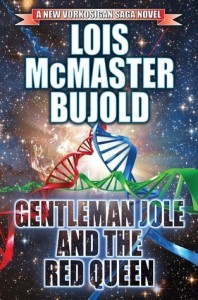
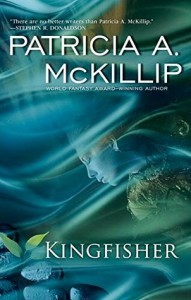
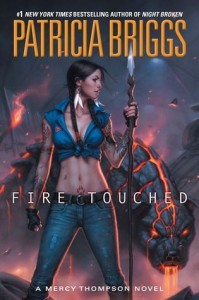
But wait! There’s so much more.
There’s IN THE LABYRINTH OF DRAKES by Marie Brennen, for example. And I see Sarah Rees Brennan has another one out, TELL THE WIND AND FIRE. And now that I’m a definite Frances Hardinge fan, it’s exciting to see THE LIE TREE will be coming out shortly.
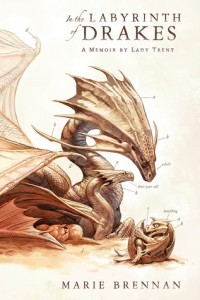
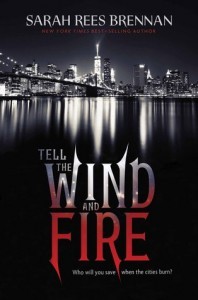
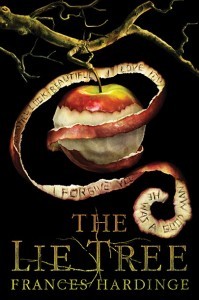
And on top of all these, Stephanie Burgess has her first adult title coming out, a historical fantasy called MASKS AND SHADOWS.

Great cover, eh? Goodreads says: “The year is 1779, and Carlo Morelli, the most renowned castrato singer in Europe, has been invited as an honored guest to Eszterháza Palace. … Music, magic, and blackmail mingle in a plot to assassinate the Habsburg Emperor and Empress — a plot that can only be stopped if Carlo and Charlotte can see through the masks worn by everyone they meet.”
And as it happens, though this one isn’t due out till April, I have an ARC right here in my hand, so I hope I will get to it well before that.
And, of course, I can think of one or two other books due to come out in 2016 that I hope will get some attention:
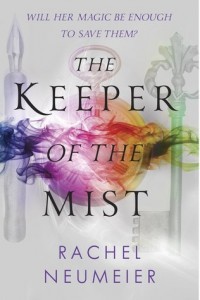
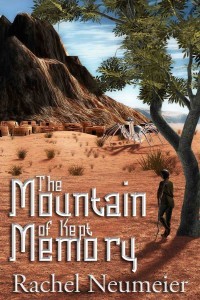
That is most likely not the actual cover for MOUNTAIN, though I like it a lot and I did send it to Saga so who knows. Since they haven’t sent me a cover sketch yet, I’ll just use this one for the moment.
So, yep, looking forward to 2016!




